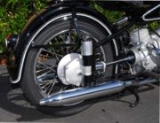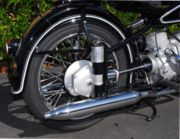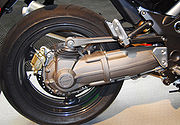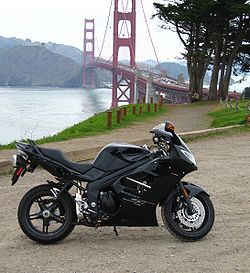
Swingarm
Encyclopedia

Suspension (motorcycle)
A motorcycle's suspension serves a dual purpose: contributing to the vehicle's handling and braking, and providing safety and comfort by keeping the vehicle's passengers comfortably isolated from road noise, bumps and vibrations....
of most modern motorcycle
Motorcycle
A motorcycle is a single-track, two-wheeled motor vehicle. Motorcycles vary considerably depending on the task for which they are designed, such as long distance travel, navigating congested urban traffic, cruising, sport and racing, or off-road conditions.Motorcycles are one of the most...
s and ATVs. It is used to hold the rear axle
Axle
An axle is a central shaft for a rotating wheel or gear. On wheeled vehicles, the axle may be fixed to the wheels, rotating with them, or fixed to its surroundings, with the wheels rotating around the axle. In the former case, bearings or bushings are provided at the mounting points where the axle...
firmly while pivoting vertically to allow the suspension to absorb bumps in the road.
Originally there was no rear suspension - the frame design being a stronger version of a bicycle frame. Many types of suspension were tried including Indian
Indian (motorcycle)
Indian is an American brand of motorcycles. Indian motorcycles were manufactured from 1901 to 1953 by a company in Springfield, Massachusetts, USA, initially known as the Hendee Manufacturing Company but which was renamed the Indian Manufacturing Company in 1928. The Indian factory team took the...
's leaf spring
Leaf spring
Originally called laminated or carriage spring, a leaf spring is a simple form of spring, commonly used for the suspension in wheeled vehicles...
suspended swingarm, and Matchless
Matchless
Matchless is one of the oldest marques of British motorcycles, manufactured in Plumstead, London, between 1899 and 1966. A wide range of models was produced under the Matchless name, ranging from small two-strokes to 750 cc four-stroke twins...
's cantilevered coiled spring swingarm. Immediately prior to and after WWII the "plunger" system in which the axle moved up and down two vertical posts became commonplace. In the latter, the movement in each direction was against coiled springs.
Some manufacturers such as Greeves used swingarm designs for the front forks which made them more robust than telescopic forks
Motorcycle fork
A motorcycle fork connects a motorcycle's front wheel and axle to its frame, typically via a pair of triple clamps. It typically incorporates the front suspension and front brake, and allows the bike to be steered via handlebars attached to the top clamp....
. The swingarm has also been used for the front suspension of scooters
Scooter (motorcycle)
A scooter is a motorcycle with step-through frame and a platform for the operator's feet. Elements of scooter design have been present in some of the earliest motorcycles, and motorcycles identifiable as scooters have been made from 1914 or earlier...
. In this case it aids in simplifying maintenance. Motorcycles with Shaft drive such as the Yamaha XJ650 Maxim
Yamaha XJ650 Maxim
The Yamaha XJ650 Maxim is a mid-size motorcycle by the Yamaha Motor Company introduced in 1980 as the Maxim I and produced thru 1983. Yamaha designed the high-performance XJ650 as a brand-new four-cylinder with shaft drive, and built it specifically as a special cruiser. The XJ Maxim was the...
, the shaft housing forms the left side swingarm.
Swingarm types
Swingarms have come in several forms:Swinging fork - the original version consisting of a pair of parallel pipes holding the rear axle at one end and pivoting at the other. A pair of shock absorber
Shock absorber
A shock absorber is a mechanical device designed to smooth out or damp shock impulse, and dissipate kinetic energy. It is a type of dashpot.-Nomenclature:...
s are mounted just before the rear axle and attached to the frame below the seat rail.
Cantilever - An extension of the swinging fork where a triangulated frame transfers swing arm movement to compress shock absorber/s generally mounted in front of the swingarm. The HRD-Vincent Motorcycle is a famous early form of this type of swingarm, though Matchless
Matchless
Matchless is one of the oldest marques of British motorcycles, manufactured in Plumstead, London, between 1899 and 1966. A wide range of models was produced under the Matchless name, ranging from small two-strokes to 750 cc four-stroke twins...
used it earlier and Yamaha
Yamaha
Yamaha may refer to:* Yamaha Corporation, a Japanese company with a wide range of products and services** Yamaha Motor Company, a Japanese motorized vehicle-producing company...
subsequently. The Harley-Davidson
Harley-Davidson
Harley-Davidson , often abbreviated H-D or Harley, is an American motorcycle manufacturer. Founded in Milwaukee, Wisconsin, during the first decade of the 20th century, it was one of two major American motorcycle manufacturers to survive the Great Depression...
Softail
Softail
The term softail refers to motorcycles and bicycles that feature a rear suspension system with springs or shock absorbers to absorb bumps. On Softail motorcycles, the shock absorbers or springs are often hidden underneath out of view to give the appearance of a hard-tail or rigid frame, however...
is another form of this swingarm though working in reverse with the shock absorbers being extended rather than compressed.


Paralever is BMW's version of the system. It allows the driveshaft to pivot along the same axis as the sprung rear frame due to the addition of second link between the rear drive and transmission. Paralever was originally introduced in 1988 R80GS and R100GS motorcycles and provides a reduction in the phenomenon known as "shaft jacking" where the rear of the motorcycle would lift skyward under certain riding conditions.
Moto Guzzi
Moto Guzzi
Moto Guzzi is an Italian motorcycle manufacturer. It is one of seven brands owned by Piaggio.Established in 1921 in Mandello del Lario, Italy, the company is noted for its central historic role in Italy's motorcycling manufacture, its prominence worldwide in motorcycle racing, and a series of...
has introduced a variant of the system it named the Compact Reactive Drive Shaft system (patented and named Ca.R.C.). The main difference is that the driveshaft is free to float into its structure providing much softer feedback from transmission. Additionally, the upper arm of the Ca.R.C. is not part of the structure but just a guide to close the geometry of the suspension (it means that, differently from BMW version, the suspension will work also with a broken upper arm).
Drag racing
Drag racing
Drag racing is a competition in which specially prepared automobiles or motorcycles compete two at a time to be the first to cross a set finish line, from a standing start, in a straight line, over a measured distance, most commonly a ¼-mile straight track....
motorcycles will often use longer swingarms to keep their center of gravity
Center of gravity
In physics, a center of gravity of a material body is a point that may be used for a summary description of gravitational interactions. In a uniform gravitational field, the center of mass serves as the center of gravity...
, i.e. the engine, as forward as possible to reduce the tendency to wheelie
Wheelie
In vehicle acrobatics, a wheelie is a vehicle maneuver in which the front wheel or wheels come off the ground due to extreme torque being applied to the rear wheel or wheels. Wheelies are usually associated with bicycles and motorcycles, but can be done with other vehicles such as cars, especially...
at the start.

Scooter (motorcycle)
A scooter is a motorcycle with step-through frame and a platform for the operator's feet. Elements of scooter design have been present in some of the earliest motorcycles, and motorcycles identifiable as scooters have been made from 1914 or earlier...
s, where a robust chain case doubles as the swingarm linking the engine and rear wheel. Single-sided swingarms need to be much stiffer than the double-sided versions to accommodate the extra torsional forces, and as a result they are usually heavier than double-sided arms. Having a single mounting point guarantees proper wheel alignment.
Single-sided swingarms date from at least the late 1940s. In 1948 the Imme R100 produced by Norbert Riedel of Germany had both a single-sided front wheel suspension as well as a single-sided rear swingarm that doubled as a the exhaust pipe. Later in 1950, Moto Guzzi introduced the Galetto, a large-wheel step-through scooter. In 1980, BMW
BMW Motorrad
BMW Motorrad is the motorcycle brand of the German company BMW, part of its Corporate and Brand Development division. The current General Director of the unit is Hendrik von Kuenheim....
introduced its first single-sided swingarm on the R80G/S
BMW R80G/S
The BMW R80G/S is a motorcycle manufactured in Berlin, Germany, by BMW Motorrad from 1980 to 1987. Production totalled 21,864 bikes.It was the first in the BMW GS family of specialised dual-sport bikes, of which over 500,000 have been produced....
, the "Mono-lever", which was superseded by the "Para-lever" used currently. Honda
Honda
is a Japanese public multinational corporation primarily known as a manufacturer of automobiles and motorcycles.Honda has been the world's largest motorcycle manufacturer since 1959, as well as the world's largest manufacturer of internal combustion engines measured by volume, producing more than...
currently features this style of swingarm on the Honda VFR
Honda VFR800
The Honda VFR800, also known as the Interceptor, is a motorcycle introduced by Honda in 1998. It is a successor to the VFR750F , which was preceded by the VF750.From its first sales in 1986, the VFR750F scored highly on many press reviews...
. Ducati has created several models featuring these swingarms, most notably the Massimo Tamburini
Massimo Tamburini
Massimo Tamburini is an Italian motorcycle designer for motorcycle companies including: Cagiva, Ducati, MV Agusta; and Bimota, which he founded, together with Bianchi and Morri ....
-designed 916 series
Ducati 916
The Ducati 916 is an Italian sports motorcycle manufactured by Ducati from 1994 to 1998. In contrast to Japanese inline four-cylinder competitors of the time, its V-twin engine produced less outright power, but a more even torque spread...
. While they abandoned this style for the 999
Ducati 999
The Ducati 999 superseded the Massimo Tamburini designed Ducati 916, Ducati 996 and Ducati 998 range of superbikes in 2003, and was produced through 2006...
, they returned to it for the 1098
Ducati 1098
The Ducati 1098 is a sport bike manufactured by the Italian motorcycle company Ducati since 2007. There were three different versions, called the 1098, 1098S, and 1098R...
superbike in 2007, and it survives in the current 1198
Ducati 1198
The Ducati 1198 is a sport bike made by Ducati since 2009. For the 2011 model year there are two models: the 1198 and 1198SP . The 1198 shares design elements with its predecessor 1098, but has more power and torque, redesigned wheels, lighter headlights, traction control, and lighter fairings ,...
. The Triumph Sprint ST
Triumph Sprint ST
The Triumph Sprint ST is a sport touring motorcycle manufactured in the United Kingdom since 1999 by Triumph.-955 cc:The Sprint ST was first introduced in 1999 as a complete redesign of the earlier Sprint 900 styled by Rod Scivyer...
also features single-sided swingarm.
The advantages of single-sided swingarms are (i) that it simplifies rear-wheel removal, which now involves merely undoing perhaps a single nut and then pulling the wheel off the axle shaft.
Also, (ii) (on a non-shaft drive bike) a single-sided swingarm can enable the rear chain sprocket to be separate from the wheel itself. This feature allows a full-enclosed oil-bath final-drive chain, but whereas scooters have always used this advantage, large motorcycles rarely do, even though their chains would benefit from such protection. A further advantage (iii) is that a single-sided swingarm gives a fashionable "clean" appearance to the bike's rear.

